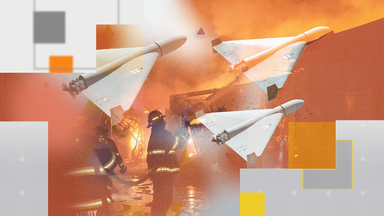Drone attacks on Ukraine reach record levels as Russia could be ‘stockpiling’ missiles for winter assault
Experts warn that Russia may be trying to deplete Ukraine’s air defences in preparation for an attack on its energy system over the winter. Ukraine has also increased its use of long-range drones in recent weeks, with videos showing damage to Moscow’s suburbs.

Russia has dramatically scaled up its long-range drone attacks on Ukraine, in an effort that analysts say could be intended to grind down the country’s air defences.
New data from conflict-monitoring organisation ACLED shows the number of reported Shahed drone attacks has surged in recent weeks, and that incidents have been reported across the country.
The largest number of reported attacks have targeted the northern province of Sumy, near the border with Russia, and the capital city, Kyiv. Strikes were also reported as far west as Ivano-Frankivsk and Rivne, both more than 600km from the front line.
A total of 54 separate incidents involving Shahed drones were reported in the latest week of data, up to 8 November. That’s the highest since Russia first began using the drones in Ukraine in September 2022.
The video below, uploaded on 7 November and geolocated by Sky News, shows one of those Shahed drones flying over southeastern Kyiv.
The recent spate of attacks includes what Ukrainian officials say is Russia’s largest drone barrage since the war began.
On Saturday night, authorities said Russia attacked with 145 Shahed drones. Just 62 were shot down, according to Ukraine’s air force, and extensive damage was reported in the coastal city of Odesa, far from the front lines.
Read more: How Ukrainian anti-aircraft units are downing Russian drones
Ukraine says Russia is sending 85 drones each day
The increase in Russia’s use of long-range drones is also evident in the daily reports shared by Ukrainian authorities – who measure not only the number of incidents, but also the number of drones used.
Since the start of November, Ukraine has reported 1,105 Russian drones entering their territory. That’s a daily average of 85 drones, compared to just 11 per day in June.
Before October, Ukraine had consistently managed to shoot down at least three quarters (77%) of Russian drones each month, according to data from conflict-monitoring group the Centre for Information Resilience (CIR).
That interception rate has now dropped to just 56%, Sky News has found, suggesting that Ukraine’s air defences are struggling with the quantity of attacks.
“We’re talking dozens and dozens [of drones] every night,” Matthew Savill, director of military sciences at the Royal United Services Institute (RUSI) thinktank, said.
“The sheer volume requires some kind of response, but not at the expense of using the most sophisticated and expensive interceptor missiles, which you would want to hold back for cruise missiles or to use against Russian aircraft.
“What the Russians are trying to do with these constant air attacks is wear down even those smaller missiles.”
CIR says it has observed an increasing number of drone attacks occurring during daylight hours, which they say suggests these drones are intended to be spotted and to use up air defence munitions.
The organisation also warns that Russia may have reduced its use of missiles in order to stockpile them for a large-scale attack this winter.
In June, Russia reportedly fired an average of 4.2 missiles per day into Ukraine. In the first 12 days of November, that number was just 1.6 – a decrease of almost two-thirds (62%).
George Barros, team lead for Russia and geospatial intelligence at the Institute for the Study of War (ISW), agrees and says Russia may be “stockpiling” missiles for a large-scale attack on Ukraine’s energy infrastructure over winter.
“The Ukrainians are going to have a difficult winter,” he said.
“They’re very resilient and they’ve found ways to mitigate the effect of Russian attacks, but at the same time the Russians have also learnt – they’ve managed to find more effective and creative ways of penetrating Ukraine’s air defence.”
Ukraine has also increased its use of long-range attack drones
Ukraine has also increased its use of long-range attack drones targeting Russia in recent months. A strike in the early hours of Sunday morning involved 84 attack drones, according to Russian authorities.
Ukrainian officials said they had successfully targeted an ammunition warehouse at a military facility in Bryansk. Photos posted online and verified by Sky News shows a plume of smoke rising from the area of the military facility.
Russian authorities said the attack also targeted Moscow, with air defences shooting down 32 Ukrainian drones in just 90 minutes.
A video posted on social media on Sunday and verified by Sky News shows what appear to be Russian air defences being activated south of Moscow.
A second video, also uploaded on Sunday, shows cars on fire in a residential area just one kilometre east of where the air defences were activated.
Another video shows a building on fire 1.5km to the north of the air defences.
The coming months will be crucial
US president-elect Donald Trump has pledged to end the war “within 24 hours”, without explaining how. His inauguration in January therefore marks the potential start of peace negotiations, in which both Russia and Ukraine are expected to compromise their war goals.
“It stands to reason that both sides will be seeking to gain some advantage or lock in some advantages ahead of Trump coming in as president,” said Mr Savill.
“If they are assuming that Trump will try to accelerate to some kind of negotiation… then the position of the front line is quite important.”
Both Mr Barros and Mr Savill say Russia’s priority is expanding its area of control in the east, within the four provinces it unilaterally claimed as part of Russia in September 2022.
“They are pressing in pretty much all of those at the moment,” Mr Savill said.
Russia has slowly been making territorial gains over the last month, taking control of around 900 square kilometres in eastern Ukraine, according to the ISW.
Mr Barros says the “vast majority” of this land is “agricultural land”.
“It does change the map and it looks like a big deal, but… it’s not going to be decisive,” he added.
More important is whether Ukraine can maintain its successful defence of the operationally significant towns Chasiv Yar and Pokrovsk, along the Donetsk front line. Mr Barros said Pokrovsk is particularly significant, as it sits at the junction of critical Ukrainian supply lines.
“If the Ukrainians were to lose Pokrovsk it would make the further defence of Donetsk Oblast significantly more difficult,” he said, adding it would also give Russia a route to intensify operations against Dnipro and Zaporizhia Oblasts – “which would be very bad”.
Kursk offensive
In recent days, however, Russia has also redoubled its efforts in Kursk – the Russian province which Ukraine invaded in August – and in recent weeks has retaken parts of the province.
Footage released by the Ukrainian Ministry of Defence shows the fighting in Kursk Oblast has intensified in recent days.
The footage, geolocated by Sky News, shows numerous Russian armoured vehicles being targeted around the town of Pogrebki.
The Ukrainian government claims its troops destroyed “28 units of armoured equipment” during this effort.
Ukraine says Russia has increased its troop numbers in the province to 50,000, including 11,000 North Korean soldiers, and is gearing up for a major fight.
Ukraine is likely to remain on the defensive over the coming months, according to Mr Savill.
“There’s no significant prospect of them being able to break through and gain new territory,” he said.
“What they will want to do is show they can still fight, show they can still hurt Russia on its territory and eat into its advantages. But critically, they’ve got to be able to stabilise such that they either don’t lose further ground.”
Additional reporting by Saywah Mahmood, data journalist, and Sam Doak, OSINT producer
The Data and Forensics team is a multi-skilled unit dedicated to providing transparent journalism from Sky News. We gather, analyse and visualise data to tell data-driven stories. We combine traditional reporting skills with advanced analysis of satellite images, social media and other open source information. Through multimedia storytelling we aim to better explain the world while also showing how our journalism is done.



